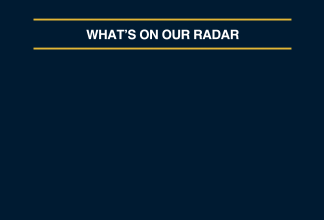What You Need to Know About Rising Interest Rates and Your Investments
Written by The Inspired Investor Team
Published on July 22, 2022
minute read
Share:
In a surprise move on July 13, 2022, the Bank of Canada (BoC) increased its key interest rate by one full percentage point, bringing Canadians the largest individual hike in over two decades.
This raises the central bank's policy rate to 2.5 per cent, and comes after three smaller rate hikes earlier this year ranging from one quarter to one half of a percentage point each.
“Normally, there's an increase of 25 basis-points (0.25 per cent) at every second Bank of Canada meeting during a sleepier tightening cycle," says Eric Lascelles, Chief Economist for RBC Global Asset Management. “We're going eight times faster than normal at this juncture."
This historic hike comes at a time of stubbornly high inflation – 7.7 per cent in May 2022 – with the central bank revising its growth forecasts for the Canadian economy significantly lower for this year and next. It attributed the downward revisions to higher inflation, tighter financial conditions, ongoing supply chain disruptions and weaker foreign demand.
How higher interest rates affect investments
While higher interest rates can create added stress for many Canadians already concerned with growing debt loads, they can also have a positive effect on certain types of investments.
In the current environment, understanding the relationship between interest rates and investments can help you make stronger investing choices. Here are some key points to keep in mind:
Savings and Guaranteed Investment Certificates (GICs)
When borrowing rates increase, as they have lately, financial institutions have more room to offer competitive interest rates on their savings accounts and GICs. Located on the lower end of the risk and return spectrum, GICs offer buyers safety and stability in unpredictable environments. Investing in a GIC typically requires clients to lock in for a specific period of time, more commonly known as a term. Term length can range anywhere from one day to several years.
In exchange, the GIC earns interest. The interest rate is known at the time of purchase and depends on a variety of factors such as market conditions, term length (in general, the longer the term, the higher the interest rate), whether or not it's redeemable, and other unique characteristics of the GIC.
Debts
Those with high debt loads may start to feel more pinched when interest rates rise. Canada's major financial institutions use the policy rate set by the Bank of Canada to determine interest rates for variable mortgages, loans and lines of credit. Individuals with variable-rate debt will be impacted the most, owing higher amounts of interest on their loan.
Credit cards and auto loans, for example, won't be affected as much since they're generally fixed-rate debt. Fixed-rate mortgage holders may face higher rates upon renewal, particularly if the rate has increased multiple times since the start of their mortgage term.
Equities (or Stocks)
Typically, when interest rates rise, stock markets decline. Because borrowing becomes more expensive, people and businesses tend to spend less. This decreased spending may mean companies hire less or have layoffs, see lower productivity and face reduced earnings. These effects often cause stock prices to fall. However, if a rate hike is seen as a sign of the Bank of Canada's confidence in the economy, there may be a smaller negative impact on the stock market.
Bonds
Much like GICs, government bonds give you a fixed rate of interest and return your initial investment at maturity. These are more flexible than GICs because you can cash in your bonds at any time, although you may have to sell them at a loss. Government bond prices and interest rates generally move in opposite directions – when one goes up, the other goes down. A bond may offer higher yields (that is, generate higher expected earnings) when markets start to anticipate an increase in rates.
Margin accounts
A margin account is a brokerage account that lets you access additional funds by borrowing against the value of your investments. The funds are loaned to you based on an interest rate that changes periodically. Because rising interest rates mean a rise in the cost of borrowing, this usually means you have to pay more to borrow against your existing investments.
RBC Direct Investing Inc., RBC Global Asset Management Inc. and Royal Bank of Canada are separate corporate entities which are affiliated. RBC Direct Investing Inc. is a wholly owned subsidiary of Royal Bank of Canada and is a Member of the Investment Industry Regulatory Organization of Canada and the Canadian Investor Protection Fund. Royal Bank of Canada and certain of its issuers are related to RBC Direct Investing Inc. RBC Direct Investing Inc. does not provide investment advice or recommendations regarding the purchase or sale of any securities. Investors are responsible for their own investment decisions. RBC Direct Investing is a business name used by RBC Direct Investing Inc. ® / ™ Trademark(s) of Royal Bank of Canada. RBC and Royal Bank are registered trademarks of Royal Bank of Canada. Used under licence. © Royal Bank of Canada 2022.
Any information, opinions or views provided in this document, including hyperlinks to the RBC Direct Investing Inc. website or the websites of its affiliates or third parties, are for your general information only, and are not intended to provide legal, investment, financial, accounting, tax or other professional advice. While information presented is believed to be factual and current, its accuracy is not guaranteed and it should not be regarded as a complete analysis of the subjects discussed. All expressions of opinion reflect the judgment of the author(s) as of the date of publication and are subject to change. No endorsement of any third parties or their advice, opinions, information, products or services is expressly given or implied by RBC Direct Investing Inc. or its affiliates. You should consult with your advisor before taking any action based upon the information contained in this document.
Furthermore, the products, services and securities referred to in this publication are only available in Canada and other jurisdictions where they may be legally offered for sale. If you are not currently a resident of Canada, you should not access the information available on the RBC Direct Investing Inc. website.
Explore More

Here’s What Every Canadian Should Know About Estate Planning
Insights from Leanne Kaufman to help you feel more confident as you plan
minute read

3 Things We're Watching This Week
What the Inspired Investor team is watching
minute read

What’s Driving the Recent Surge in Gold Prices
Here are some things to watch with the gold market
minute read
Inspired Investor brings you personal stories, timely information and expert insights to empower your investment decisions. Visit About Us to find out more.







